Response of Trachypogon plumosus pastures intercropping with Stylosanthes capitata cv. Lavradeiro to phosphate and potassium levels
DOI:
https://doi.org/10.22256/PUBVET.V11N10.1046-1056Keywords:
Botanic composition, calcium, dry matter, fiber, nitrogen, phosphorus, potassiumAbstract
Was evaluated the effect of phosphate (0, 40, 80 and 120 kg of P2O5 ha-1) and potassic fertilization (0, 40, 80 and 120 kg of K2O ha-1) on the forage yield, chemical composition and macronutrients extraction of native pastures of Trachypogon plumosus intercropping with Stylosanthes capitata cv. Lavradeiro in Roraima´s savannas. The effects of phosphate and potassic fertilization on legume forage yield were positive and linear, while for the grass and sum of components (grass + legume) were quadratic and the maximum yields estimated with the application of 73.8 and 105.1 kg of K2O ha-1 and 84.5 and 108.5 kg of P2O5 ha-1, respectively. Nitrogen, phosphorus, calcium, magnesium and potassium contents and extraction of grass and legume were quadratically affected by phosphate and potassic fertilization. Macronutrient extractions by grass and legume, independently of phosphate and potassic fertilization, were higher for N and K, followed by Ca, Mg and P. Phosphate and potassic fertilization provided grass and legume forage with better quality and lower fiber contents. Considering the overall availability of forage and pasture botanical composition - satisfactory grass/legume relationship - the use of phosphate levels between 80 and 90 kg of P2O5 ha-1 and 60 and 70 kg de K2O ha-1 can allow the establishment and yield stability and persistence of grass-legume mixture.
Downloads
Published
Issue
Section
License
Copyright (c) 2017 Newton de Lucena Costa, Anibal de Moraes, Paulo César Faccio de Carvalho, Vicente Gianluppi, João Avelar Magalhães

This work is licensed under a Creative Commons Attribution 4.0 International License.
Você tem o direito de:
Compartilhar — copiar e redistribuir o material em qualquer suporte ou formato
Adaptar — remixar, transformar, e criar a partir do material para qualquer fim, mesmo que comercial.
O licenciante não pode revogar estes direitos desde que você respeite os termos da licença. De acordo com os termos seguintes:
Atribuição
— Você deve dar o crédito apropriado, prover um link para a licença e indicar se mudanças foram feitas. Você deve fazê-lo em qualquer circunstância razoável, mas de nenhuma maneira que sugira que o licenciante apoia você ou o seu uso. Sem restrições adicionais
— Você não pode aplicar termos jurídicos ou medidas de caráter tecnológico que restrinjam legalmente outros de fazerem algo que a licença permita.





